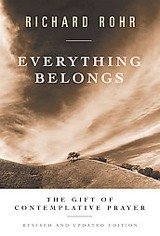Engaging your Intellect through Meditatio
As the second step of Lectio Divina, Meditatio has the goal of growing your mental understanding of, or insight into, that which you have read.
To continue with the metaphor that I introduced on the Lectio page, we're now ready to start chewing and breaking down — through Meditatio — the food that's been placed in our mouths — through Lectio. We have one of two ways of doing this.
We can take the focus verse, or a part of it, and repeat this over and over in our minds, waiting for new thoughts and insights about it's meaning to come to us. It's like you're just patiently and observingly moving from the one thought to the next. This is called discursive meditation. You'll find this to be the easier way to apply this to most of the bible.
 Meditatio — thinking
Meditatio — thinking
through discursive meditation
Alternatively, as you read the stories and parables of Jesus, another way of practicing Meditatio is to imagine yourself as a part of what happens in the story. Read the story or parable and imagine you are one of the characters mentioned — or even just a bystander witnessing the scene. See if this unusual mental picture of what transpires in the story offers you any fresh insights into the meaning or message of the story.
This second approach is not always possible, however, as most of the bible is not written in such narrative form.
I will be illustrating the first way of practicing this thinking process, through discursive meditation, in the example below. This is what will prove useful most of the time. I believe that the second way is self-explanatory. Tap into your own creativity to apply it where possible.
Our Practical Example Continued
Consider once again the focus verse from our Lectio page:
"Listen carefully: Unless a grain of wheat is buried in the ground, dead to the world, it is never any more than a grain of wheat. But if it is buried, it sprouts and reproduces itself many times over. In the same way, anyone who holds on to life just as it is destroys that life. But if you let it go, reckless in your love, you'll have it forever, real and eternal." — John 12:24-25, The Message
Now, spend about ten minutes and take the concept of how the grain of wheat dies and produces fruit, and apply this to your own life. Think. Repeatedly ask yourself in what ways you need to die to really live. As one thought comes, note it, and move on to the next thought.
As you calmly repeat the question over and over to yourself and move between thoughts, be on the lookout for new ways of understanding the concept. Become aware of fresh insights as to how this applies to you and your life situation.
Can you see how you are now reading your own life through the lens of the bible? Instead of taking a part of the bible that you identify with, and adding that to your favorite verses list, you are taking something challenging and inspecting your own life through the teaching offered.
The idea here is only to think. In spirituality your brain, thoughts or intellect is often downplayed because it is not your true identity. One popular spiritual teacher is specifically well-known for his claims that you are not your thinking. This is a true and ancient wisdom that the Christian Mystics taught.
However, keep in mind that with this step, instead of identifying with your mind or thoughts, you are merely using it as a helpful tool in the process of truly comprehending the message of the bible, or other sacred text. More than comprehending, you are applying it to your own life situation.
I hope this short, simple explanation is sufficient to help you put this step of Lectio Divina to good use. Regular practice will help you become more comfortable with this.
Conclusion
So, here's the short version... Mediatio is the second step of Lectio Divina. You have two ways of practicing this step.
- You can take the main concept of your focus verse and apply discursive meditation by going from one thought to the next. You continue with this, picking up new understandings and fresh insights as you progress. The idea is to look at your own life through the lens that the bible provides, and not the other way around.
- Or, where the text lends itself to it, you can imagine yourself as part of the story, parable or scene from the text and as you do so, see if it takes on a new meaning or deeper understanding for you. Here you'll need a healthy dose of imagination.
Next up we have the third step — Oratio, or prayer.
A Suitable Quote...
"How do you make attractive that which is not?
How do you sell emptiness, vulnerability and nonsuccess?
How do you talk descent when everything is about ascent?
How can you possibly market letting-go in a capitalist culture?
How do you present Jesus to a Promethean mind?
How do you talk about dying to a church trying to appear perfect?
This is not going to work (admitting this might be my first step)"
— Richard Rohr at the beginning of his book Everything Belongs...



